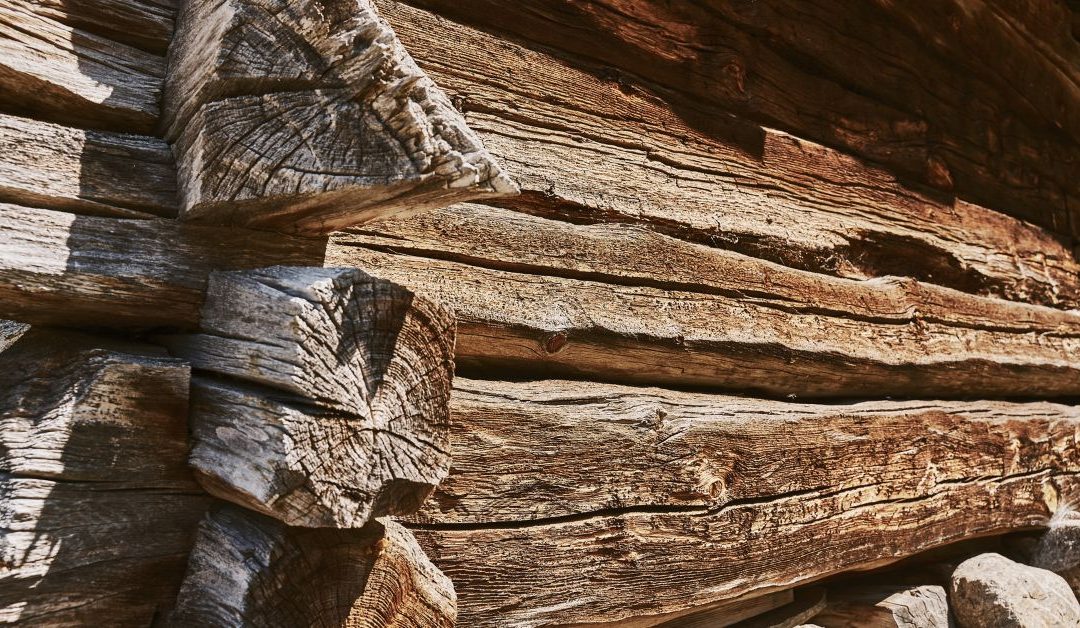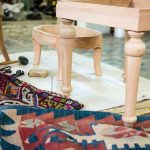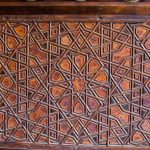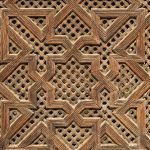Moroccan woodworking is a craft that’s been important for many years in the country. It combines old and new methods, especially when making decorative things like carved doors and latticework.
This article explores the impact of Moroccan woodworking on trade between North African nations and the world. We’ll see how this craft evolved and how it affected different cultures. We’ll learn how it opened up new opportunities for commerce between Morocco and other countries.
Early History Of Moroccan Woodworking
Generations have passed down the ancient craft of Moroccan woodworking. It dates back centuries and is still important today.
Artisans use inlay, marquetry, and carving to craft beautiful furniture and decorations. People from all over the world loved these unique pieces because of their style and high-quality workmanship.
Long ago, Moroccan woodworkers traded their creations with people from different countries. As more and more people saw these amazing pieces, they wanted them too. This made Moroccan woodworking a popular export from the country.
Other countries were also inspired by Moroccan woodworking and started using some of its elements in their crafts. This created a mix of cultures and became very influential in history.
Even today, we can see how important Moroccan woodworking has been in the world’s trade routes. And we can still see its impact through the talented artisans who continue this ancient craft.
Traditional Craftsmanship Techniques
Moroccan woodworking is an old craft that has had a big impact on the world. Artisans have passed down the unique traditional techniques used in this craft for a long time.
- Handcrafted Tools: Local artisans make their tools, which makes each finished product special and of high quality.
- Sustainable Harvesting: Woodworkers use traditional methods to get wood without hurting the environment. They make sure there is enough wood for production without using too much.
- Artisanal Techniques: Each step in the process requires skill and patience. This is to create the best crafts, using special saws, chisels, and careful sanding.
With these techniques, Moroccan woodworkers can create beautiful works of art that can last for a very long time with proper care. By valuing quality and sustainability, they keep centuries-old traditions alive.
Woodworking In The Medieval Period
Moroccan woodworking is an old tradition that started in medieval times. Artisans used special tools to make intricate designs in different types of wood. They created furniture, platters, jewelry boxes, doors, and window frames for local use and also exported them to faraway places.
Through global trade routes, the skill of Moroccan woodworking spread to Europe and North Africa.
Today’s modern style of Moroccan woodwork goes back to its roots in medieval times. Each piece made then was special and had a special meaning for those who commissioned it or gave it as a gift. Wood carvings with geometric shapes and traditional motifs could take days or weeks to complete. This depends on the design complexity.
Moroccan craftsmen pass down their skills for generations, creating beautiful art for centuries. While some methods have changed with new technology, much remains the same – showing how important this craft is in Moroccan culture.
Having a handcrafted piece made by skilled hands is a great honor for Moroccans and people from other cultures too. These items are much sought after all around the world.
Moroccan Woodworking During The Renaissance
During the Renaissance, Moroccan woodworking looked very different and was super artistic. People from all over the world loved the incredible craftsmanship.
The culture of each region influenced its style of woodworking. They crafted intricate carvings and patterns on furniture. Examples of these are desks, chairs, cabinets, and chests, using a blend of bright colors inspired by both Eastern and European styles.
These amazing creations were not only in Morocco but on trading ships too traveling the Mediterranean Sea, so they spread to many places.
Moroccan woodworking bridged different cultures, still relevant today. Skilled artisans carry on this tradition and make beautiful wooden goods that blend old and new styles.
Expansion Of Craftsmanship In The 19th Century
In the 19th century, Moroccan woodworking grew a lot because of new technology and global trade. This helped craftsmen make more intricate pieces and earn more money. Skilled craftspeople came to Morocco, which boosted the industry even more.
The woodworking boom had many benefits for Morocco. Local entrepreneurs earned money by selling products to other countries. This helped improve their education, healthcare, and infrastructure. It allowed as well different societies to learn from each other’s cultures. Plus, supported both traditional and modern techniques to grow together.
Design Elements In Moroccan Woodwork
Moroccan woodworking is famous for its detailed designs and cultural influences. The artisans use geometric shapes like stars, squares, and circles, with colors like red, blue, and yellow. Wood carvings add depth to their work, making everything from small trinkets to big doors or tables look amazing.
Not only do these creations look great, but they had an impact too on trade routes long ago. Merchants admired and bought these unique pieces, spreading the art beyond Morocco.
Examples of design elements that appear in Moroccan woodwork include:
- Intricate geometric patterns
- Bright colors inspired by nature
- Detailed carvings symbolizing religious beliefs
- Symbols related to local folklore
- Regional motifs reflecting distinct customs
Moroccan woodworking has made a big impact not only in Morocco but all around the world. Its timeless works of art will always be much admired and appreciated.
Carved Doors As A Symbol Of Status
In ancient times, people traded detailed designs of Moroccan woodworking all over the world.
The doors are especially important, showing off wealth and status, and they have unique patterns, symbols, and colors.
These doors came from materials like cedar, walnut, oak, olivewood, and lemon trees. Some doors even have brass decorations, which were popular with wealthy people.
Many of these doors still exist today, giving us a glimpse into the past when Moroccan woodworking was both useful and beautiful.
These creations tell stories of the past, connecting cultures and ideas through trade networks bigger than today.
They are marvels to behold!
Woodworking For Export And Trade
Moroccan woodworking had a big impact on the ancient world’s trade routes. People made beautiful pieces from sustainable materials and sold them in different countries. These special works were much loved and sought after in Europe, Asia, and Africa.
Back then, Morocco’s economy relied on exporting and selling wooden crafts at high prices. This helped local communities earn money and thrive. Many people learned specific skills to be part of this successful industry.
Moroccan woodworking exported furniture, containers, decorative objects, and architectural elements. These items didn’t only stay in Morocco but traveled to faraway places where people loved them.
Moroccan Woodworking In The Modern Age
Morocco’s woodworking craftsmanship is amazing and has been much admired for hundreds of years. The intricate designs in the furniture are like pieces of art, and people are in awe of the skill and talent it takes to create them.
People worldwide celebrate Moroccan woodworking for its cultural significance even today. The furniture pieces are still carved with greatness, and new materials like metal give craftsmen more freedom to be creative. Different cultures’ influences as well add to the unique styles of Moroccan woodwork, making it even more special.
As more people learn about this incredible craft, they will continue to cherish it for many generations. Moroccan woodworking is a symbol of beauty and grace, making it magical.
Impact Of Moroccan Woodworking On Global Trade Routes
Long ago, Moroccan woodworking had a big impact on the world’s trade. Craftsmen from North Africa made beautiful items like furniture and jewelry boxes from different types of wood. People admired these items so much that they traded them all over Europe and Asia.
This trading led to the exchange of ideas, goods, and services between different cultures, and it made many people wealthy. The Moroccan artisans were very skilled and creative, and their intricate designs showed that.
As their products became more popular, demand for them increased, and Morocco’s influence in global trade grew. This brought economic opportunities for the artisans. They could use the money they earned to buy materials and invest in new projects.
Moroccan woodworking had a significant role in global trade. Thanks to the beautiful and valuable items made by skilled craftsmen.
Frequent-Asked Questions
What Kinds Of Wood Are In Use In Moroccan Woodworking?
Moroccan woodworking is famous for choosing strong and beautiful woods. Craftspeople select cedar, cypress, walnut, rosewood, and citrus trees like lemon, orange, and lime. They use these to create long-lasting pieces. These woods not only look great but also have cultural meaning that makes each work special.
How Is The Quality Of Moroccan Woodworking Products Determined?
When we judge the quality of Moroccan woodworking products, we should consider two important things. These are how skilled the craftsmen are and what type of wood they use.
Expert artisans in Morocco use different types of wood, such as cedar and juniper, to make their beautiful creations. They put a lot of effort into making each piece right.
Moroccan woodworkers select materials and craft with intricate carvings, ensuring top-notch pieces. Their skill and attention to detail earned them a great reputation. They became famous for producing high-quality, durable products.
What Impact Has Moroccan Woodworking Had On Other Countries In The Region?
Moroccan woodworking is famous for its traditional techniques and top-quality products. It has influenced many other countries in the region. It inspired them to create their unique pieces while keeping their cultural heritage alive.
Moroccan woodworking uses renewable materials like cedarwood and olive trees. This is to reduce its impact on nature. These beautiful creations help families in the region make a living.
Are There Any Laws Or Regulations Related To The Production Of Moroccan Woodworking?
Morocco’s woodworking has a long history and is famous for its intricate designs and attention to detail.
There are rules in place to make sure these works of art meet environmental standards and quality laws.
As an expert in Moroccan woodworking, I know how crucial it is to follow these rules. They help preserve the beauty and legacy of these historical pieces, keeping them in our homes and hearts for generations.
How Does The Pricing Of Moroccan Woodworking Compare To Other Countries?
When looking at the cost of Moroccan woodworking, you need to think about trade tariffs and prices from other countries too.
For example, Chinese manufacturers often have lower production costs. This made them have cheaper prices than Morocco.
But, depending on what you’re buying, taxes could be higher, or there might be shipping costs from China that cancel out the savings.
So, it’s important to check and compare to find the best value for your project.
Moroccan woodworking has been a meaningful form of art for a long time, and it played a big role in ancient trade routes.
We need to protect and preserve this craft for the future.
Moroccan woodworking products have always been popular. With good rules, prices, and quality, it can continue to be successful in Morocco and beyond.
With its beautiful designs and carvings, Moroccan woodworking is a special part of our culture that we should all admire and cherish.







